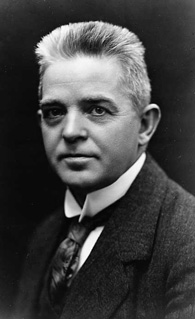Carl Nielsen
카를 닐센 (Carl August Nielsen, 1865년 6월 9일 ~ 1931년 10월 3일) 은 덴마크의 지휘자이자
생애
뇌레 린델세 주 (Nørre Lyndelse) 소르텔룽(Sortelung)에서 태어났다. 소년 시절에 군악대의 트럼펫 주자가 되면서부터 음악 생활을 시작했다. 코펜하겐 음악원의 가데에게서 작곡법을 배우고, 작곡가·지휘자로서 활약했다. 북유럽 음악가 중에서는 그리그 이후의 대표적 작곡가이다. 닐센의 초기음악에서는 낭만주의 영향이 엿보이지만, 후기 양식은 반음계적이고 종종 불협화적인 화성, 엄격한 대위법 구조, 압축적인 동기처리, 조성의 대담한 확장, 빈번한 다조적 악구사용 등의 특징들이 뒤엉켜져 있다. 1890~1925년 작곡된 6개의 교향곡은 음조의 진행상태를 명확하게 보여주는 작품이다.
그밖에도 〈사울과 다윗 Saul and David〉(1902)을 포함한 2개의 오페라와 3개의 협주곡, 실내악, 합창,
건반음악 작품들이 있다. 덴마크의 민속전통에 바탕을 둔 그의 가곡은 특히 높은 평가를 받고 있다.
Little Suite for Strings (Nonet), Op.1
Carl Nielsen's Suite for Strings was one of the composer's earliest works and was first performed at the Tivoli Hall on 8 September 1888.
Nielsen composed the Suite for Strings when he was only 22 and was still studying composition with Orla Rosenhoff, his former teacher at the Conservatory. It was first performed on 8 September 1888 at the Tivoli Hall in Copenhagen where the Tivoli Orchestra was conducted by Balduin Dahl, a recognised supporter of young talent. It was a great success. Nielsen, who played in the orchestra, was called back several times and the middle movement was played as an encore. Press reviews were mixed, but Avisen was very positive: "The young man obviously has a great deal on his musical mind that he wants to say, and what he told us on Saturday was presented in a beautiful, concise form, modestly and attractively, with excellent part-writing and an appealing fullness of sound that reveals an excellent eye for the string material." The work marked an important milestone in Nielsen's career as it was not only his first real success but it was also the first of his pieces he conducted himself when it was played in Odense a month later.
In an interview with Pressens Magasin in 1918, Nielsen said that the movements had subtitles: "The Danaids", "The Dance of the Charites" and "The Bacchus Procession".
The Suite for Strings was published by Wilhelm Hansen in 1990 with alterations by Nielsen, especially in the third movement.
The Suite's rather short elegiac first movement is reminiscent of Scandinavian Romanticism as expressed by Grieg and Svendsen. The Intermezzo gives a hint of the composer's love of triple time: it's appealing waltz is peppered with the occasional flat seventh grace notes that would later become so characteristic of Nielsen's music. The comparatively expansive Finale opens solemnly with the elegy theme but soon breaks loose into an animated sonata form in which Nielsen demonstrates his mastery by cleverly reintroducing the opening theme.
'♣ 음악 감상실 ♣ > - 9중주(NONET)' 카테고리의 다른 글
| George Onslow - Nonet in A-minor, Op 77a (1848) (0) | 2016.10.22 |
|---|---|
| Samuel Coleridge- Taylor : Nonet in F minor,Op.2(1894) (0) | 2016.10.14 |
| 9중주(Nonet) 모음 (0) | 2016.03.23 |
| Louis Spohr: Nonett in F Major op. 31 (0) | 2015.08.20 |
| Josef Rheinberger - Nonet in E-flat major, Op.139 (1884) (0) | 2015.08.18 |
